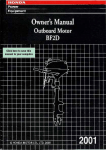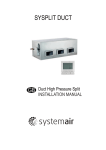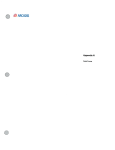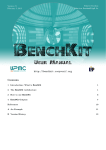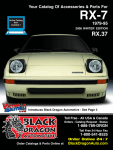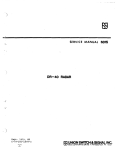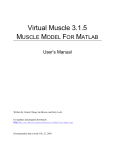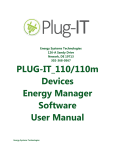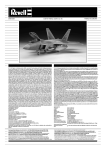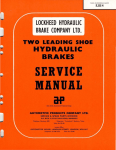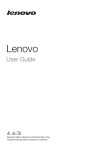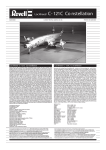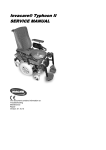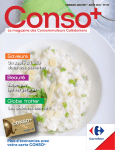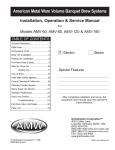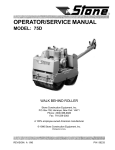Download Hydraulic Brakes (Prior to Two Leading Shoe) For Cars And Light
Transcript
WHEN RE·ORDERING QUOTE 5110/2 LOCKHEED HYDRAULIC BRAKE COMPANY LTD. HYDRAULIC BRAKES (PRIOR TO TWO LEADING SHOE) FOR CARS AND LIGHT COMMERCIAL VEHICLES SERVICE MANUAL One of (he Aucomotillt Producu Group AUTOMOTIVE PRODUCTS COMPANY LTD. SERVICE. SPARE PARTS DIVISION P.O . BOX 14, SOUTHAM ROAD, BANBURY Te/t:phone ~ Banbury ....21 Telecroms ' "Autoducu" Banbury. Telex rt/.. No. 83106 London Office AUTOMOTIVE HOUSE, LANGHAM STREET, LONDON, WIN 'AT rt/.""o"., 01 sao 2527 rt'" No. 23+46 SERVICE MANUAL .;:;:h ~ • 19 6 6 C CENUINE HYDRAULIC BRAKES (PRIOR TO TWO LEADING SHOE) FOR CARS AND LIGHT COMMERCIAL VEHICLES INDEX Page SECTION I. DESCRIPTION AND OPERATION I SECTION 2. ROUTINE ATIENTION ._. 3 SECTION 3. ADJUSTMENTS _.• S SECTION 4. OVERHAUL INSTRUCTIONS 9 SECTION 5. BLEEDING AND FLUSHING 21 SECTION 6. FAULT FINDING 23 ilP One of the Automotive Products Group SECTION I DESCRIPTION AND OPERATION SECTION 1 DESCRIPTION AND OPERATION contact the drums. One shoe of each brake assembly will be applied in the same sense of rotation as the drum and is termed the" leading shoe." the other is applied in the opposite sense of rotation and is termed" trailing ." The braking system comprises four leading and trailing shoe brake asemblles which are operated by fluid pressure generated in a master cylinder. Each fronc brake assembly has two brake shoes mounted upon an anchor pin in the brake backplate. and a dou ble-piston wheel cylinder is located between the free ends of the shoes . The rear brakes are similar co those at the (ron[ except that. with car brakes. a lever mechanism is provided (or hand brake operation ; in the Instance of light comme rcial vehicle brakes the place of the wheel cylinder is taken by a bisector assembly which is operated by a transverse wheel cylinder at the rear of the backplate. The master cylinder is connected to the brake assemblies When the pressure on the brake pedal is released. the brake shoe pull-off sp rings cause the brake shoes to move away from the drums, and the wheel cylinder pistons are thrust back to the "off" posit ion; whilst this is occurring, flu id is displaced back to the master cylinder ready for the next brake applicat ion . by means of metal tubing and flexible hoses. From the very simplified diagram of a typical braking system (Fig. 1) it will be seen that the master cylinder. pipeline and wheel ,cylinders form one vessel which is filled with Lockheed Hydraulic Brake Fluid . The master cylinder has a single piscon. whilst each wheel cylinder has two. all pistons being provided with rubber seals to maintain pressure and prevent loss of fluid. When the brake pedal is depressed. the master cylinder piston applies a force to the fluid which. being incompressible, is displaced through the pipes and thrusts the wheel cylinder pistons apart until the brake shoes 2 SECTION 1 ROUTINE ATTENTION 3 SECTION 2 ROUTINE ATTENTION (~) (1) The fluid level in the master cylinde r or. if applicable. in t he sepa rate supply tank. should be checked every 1,000 miles or once a month (whichever occurs first) and replenished if necessary. Prior to unscrewing the filler cap. clean the area around It to prevent dire Every 5.000 miles examine brake linings and renew if worn to less than a third of their original thickness . Check brake drums for excessive wear and ensure that linings are not contaminated by lubricating oil or grease. Whilst doing this. also check for wheel cylinder and master cylinder leakage. entering when it is removed . The correct fluid level is to within t in . below the bottom of the filler cap o r ifice. G reat care should be taken not to spill any brake fluid on the bodywork of the vehicle since this fluid is injurious to paint. Refit the filler cap. together with its gasket. and securely tighten . USE ONLY GENU INE LOCKH EED SUPER 105 BRAKE FLUID TO SPEC. S.A.E. J 1703 WHEN TOPPING UP. (S) Brake hoses must be examined every 10.000 miles for any signs of leakage. chafing or general deterioraation . If there is any doubt. renew the hose. It is recommended in any case that hoses are renewed at least every three years or ~O.OOO miles . When checking hoses. also inspect metal pipes for chafing or looseness. (6) At Intervals not exceeding three years or ~.OOO miles. or at each third change of a brake lining. wh iche ver occurs first. renew all rubber cups and seals throughout the system . The addition of fluid should be required only at extremely long intervals. and a considerable fall in the fluid level would indicate an external leak at some point in the system which should be traced and rectified immediately. To check for leaks. apply firm pressure to the brake pedal whilst an assistant examines the units. pipes. hoses and fittings . The special fluid used In Lockheed brakes is one of the most important factors in the correct operation of the hydraulic system. for no equipment will give sat isfaction with incorrect fluid. When topping up or overhauling the system use only the genu ine Lockheed Super 105 Brake Fluid to Spec. S.A.E. JI703 for it lengthens the life of all internal pares. ac.ts as an efficient lubricant and operates satisfactorily under all extremes of temperature throughout the world. The u se o f any ot he r flu id nullifies a ll gua ra ntees. (2) Ensure that the air vent in the filler cap is not choked. since blockage would cause the brakes [0 drag. (3) Adjust the brakes before the pedal travels to w it hin one inch of the floor without solid resistance being felt . ~ SECTION 3 ADJUSTMENTS 5 SECTION 3 ADJUSTMENTS ---------------- In order to ensure the complete return of the piston W ith hydraulic brakes adjustmen t is carried out q uickly and easily with out t he aid of special too ls and as they are balanced automatically the re is no need to jack up all four wheels at the same time. There are several methods of setting the clearance between the shoes and drums but only t hose most commonly used are described here-if these do not apply reference should be made to the vehicle instruction manual. In all cases make sure the hand brake is off. In th e brake master cy lin der, it is necessary to provide a minimum clearance between t he piston and the push rod which operates it. so ensuring that the piston is fully back against its stop when the pedal is released . This Is important, since jfthe piston is prevented from returning fully the lip of the main cup will cover the by-pass port and prevent the escape to tank of the excess flu id drawn in to t he cylinde r during the return stroke of the piston ; the brakes would. therefore. drag or remain " on." TWO-POINT CAM ADJUSTMENT The correct pedal adjustment is set when the vehicle is assembled and should never need aiteration. A minimum clearance of nil Jack up unt il wheel revolves freely . Turn one adjuster as indicated by arrow "C" in Fig. 3 (only a partial turn is required) until the wheel is locked . Now back off the adjuster the slightest possible amount to allow the wheel to revolve freely . Repeat this operation with the other adjuster after which th is particular brake is correctly adjusted . is necessary between the push-rod and the piston. which gives a safety margin of t"-t" free pedal movement at the pedal pad (refer to Fig. 2). Th is free movement can be felt if the pedal is depressed gently by hand . Should it not be apparent. first check to make sure that the pedal is not being fouled by a d isplaced mat preventing the complete return of the pedal to the" off" position. In the event of the adjustment having been disturbed. slacken the locknut" A " (Refer to Fig 2.) and reset the length of the push-rod extension until the pedal can be depressed the correct amount before the piston begins to move. Re-tighten the locknut. Repeat the above for all brakes. SINGLE-POINT CAM ADJUSTMEN T It is not necessary to jack up the wheels where this type of adjuster is fitted . As the adjuster has to slide in the backplate to centralize itself. it is advisable to clean off all mud around it and apply a little penetrating oil which should be allowed to soak in . Turn the handwheel as indicated by ar r ow" C " in Fig . .. until the shoes are in contact with the drum . DO NOT USE ANY FORM OF TOOL ON THE HANDWHEEL. On releas ing the handwheel the adjuster will spring back and automatically set the correct shoe clearance. Repeat the above for all brakes. It may be found that a slightly finer adjustment can be made if an assistant holds the footbrake on whilst the adjustment is carried out , as this will overcome the Fi,. 2 resistance offered by the shoe pull-off spring against the turning of the adjuster. 6 SINGLE-POINT NOTCHED DISC ADJUSTMENT This method is employed where a transverse wheel cylinder is fitted on the outside of the brake backplate. Actess to the notched disc is obtained by removing the wheel dust cap . revealing a hole th rough the wheel and brake drum (Fig . 5). Proceed as follows ;- Jack up until wheel revolves freely. then turn wheel until the hole through drum is opposite notched disc. Insert screw driver or similar tool and turn disc until wheel is locked . Now turn disc in opposite direction (usually about six notches) until wheel is free to revolve again. Fig. 3 Repeat the above for all brakes of this type. IMPORTAN T.-It is necessary for the t ransverse cylinder to slide on the backplate in o rder to centralise itself when adjusting brake shoes. Clean off all mud around it and apply a little penetrating o il. Also check the fixing nuts to see that they are not holding the cylinder tightly against the backplate. The correct amount of freedom will be obtained by tightening the nuts until the double spring washers are fully compressed and then slackening them half a turn. 2-POIN T NOTCHED DISC ADJUSTMENT This method of adjustment consists of turning notched discs attached to the end caps o'f an internal wheel cylinder . thus causing the ad juster screws to t ighten or slacken the adjustment according to the direction of rotation. Fig. 4 Access to the notched discs is obtained by remov ing the wheel dust cap which reveals a hole through the wheel and brake drum (Fig. 5). Proceed as follows ;- Jack up until wheel revolves freely. then turn wheel until hole through drum is oppOS ite a notched disc. Insert a screw dr iver or similar tool and turn disc until wheel is locked . Now tu r n disc in opposite direction (usually about 4 notches) until wheel is free to revolve again. Turn wheel until hole is oppOSite other notched disc and repeat the operat ion. Repeat above for all brakes. Fig. 5 7 SECTION 4 OVERHAUL INSTRUCTIONS IN 0 E X Poge 10 ROUTINE INSTRUCTIONS MASTER CYLINDER 10 BRAKE ASSEMBLIES WHEEL CYliNDERS Internally·mounted type 17 Transve rse wheel cylinder and bisector 18 REMOVING AND REFiniNG A FLEXIBLE HOSE 9 20 SECTION 4 OVERHAUL INSTRUCTIONS that the by-pass port Is clear by probing with a piece of fine wire. The brakes will drag If the by-pass port is dogged as pressure will build up in the system, thereby forcing the shoes Into contact with the drums. The port Is deliberately drilled first with a iN drill halfway and then completed with a ' 02a N dr ill wh ich just breaks through Int o t he bore. A peen ing o pe rat ion at the point of e ntry Into th e bore obviates the risk of the main cu p teari ng o n a ragged edge. Should It be found necessary to dismantle the braking system, I.' . master cylinder or wheel cylinders, the operation must be carried out under conditions of scrupulous cleanliness. Clean off the mud and grease Dismantle on a bench before removing the un it . covered with a sheet of clean paper. Do not handle the Internal parts- particularly rubbers-wit h d irty hands. Do not swill a un it , after re moval from t he ve hicle, In paraffin, petrol or tr ic hlorethylene as t his will ru in rubber parts and, on d is mantling, will give a mis leading Impression of their original condition. Place ali metal parts In a tray of clean brake flu id to soak, afterwards dry off with a clean , flumess cloth and layout In order on a clean sheet of paper. Rubber parts sho uld be carefully examined and , If th e re Is any doubt of the ir cond it ion, a compar ison should be made with new parts. Any signs of swollen cups or perished rubber indicate that they s hould be renewed immediately. To ensure unfailing reliability, It Is usually advisable to replace ali rubber parts with new ones these being readily available in the form of Repair Kits, containing all the rubber components reqUired for each particular un it . The main castings may be swilled in industrial methylated spi rit o r Loc kheed Super 105 Brake Fluid to Spec. S.A.E. J 1703 , but if spir it is us ed all craces of the cleane r must be dried out before assembly. In the case of the mas te r cylinder, make sure All Intern al parts should be dipped in Lock heed Super 105 Brake Flu id to Spec. S.A.E. J 1703. and asse mbled wet ; wh en assembling rubber pa rts use th e fin gers only. Stores departments shou ld exercise special care in hand li ng brake parts to e nsu re that no da mage is ca used wh ich would affect t heir corre ct funct io ni ng when assembled . Rubbers shou ld be stored in a cold, dark place we ll re moved from any fumes. The type of master cyli nder used var ies accord ing to the veh icle on which It Is fi tted ; there are three main types, two of wh ich (shown on Figs. a & 9) Incorpo rat e tan ks t o hold the reserve of brake flu id wh ilst th e th ird (shown on Fig. 6) is fed from a separate tank. All three types have similar inte rnal parts and funct ion In an Ident ical manner. Some veh icles are fitted with a tandem 8. 9. 10. 11 . 11. O. 14. 1. BA RREL 2. PUSH·ROO ) , 800T ... CI RCLIP S. PISTON STOP 6. SECO NDAR'I' C UP 7. PISTON PISTON WASHER MA IN CUP SPRING RETAINER SPRING CH ECK·VALVE BODY CHECK. VAlVE CUP CHECK·VAlVE WASHER 2 Fig. 6 10 The purpose of th e check-valve is to prevent the re-entry into the master cylinder of fluid pumped Into the line during the" bleed ing " operation; th is ensures a fresh charge of fluid at each stroke of the brake pedal and a complete purge of air from the system . master cylinder (a typical example of which is shown on Fig. 10); this type of cylinder is suppl ied in two forms. with an integral reserve tank o r fe d from a separate tank (as illustrated) . Description (Refer to Fig. 6) . Kemoving the master cylinder from the vehicle. A piston (7) is contained within the barrel (1). and has a rubber main cup (9) sp r ing-loaded against its inner end; between the cup and the piston a th in washer (8) (1) In the instance of cylinde rs which are fed from a separate su pply tank. empty fluid from the tank by attaching a rubber tu be to a bleeder screw in one of the wheel cylinders. slacken the sc rew one complete turn and pump the brake pedal unt il the tank Is empt y. is fitted to prevent the cup from being drawn into the small feed holes drilled aroun d the piston-head . The outer end of the piston carries a rubber secondary cup (6) and is formed with a depression to receive the spherical end (2) Brush away any dirt from the pipe connections. disconnect the pipe from the end of the cylinder. and plug the end of the pipe to prevent the entry of dirt and/or the loss of fluid , of a push-rod (2). A rubber boot (3) which fits on the end of the barre l and on th e push-rod. prevents the Intr usion of dirt and mo isture into the cylinder. At the e nd opposite to the push-rod. a check-valve assembly is fitted . comprising a metal body (12) into which a rubber cup (13) is fitted. this assembly is loaded against a rubber valve washer (14) by the piston retur n spring (11). (3) With the types of ~ylinder shown on Figs. 8 & 9 detach the push-rod from the brake-pedal linkage ; with the other type t he rubber boot may be detached from the end ofthe cylinder. and the push-rod left attached to the linkage. Principle of operation. Depressing the brake pedal causes the push-rod to thrust the piston along the bore of the barrel. and the fluid thus displaced lifts the lip of the cup away from the holes in the check-valve body and passes to the brake wheel cylinders. (4) Unscrew the fixing bolts. detach the master cylinder from the vehicle. and drain the remaining fluid from it. Dismantling (Refer to Fig. 6) (1) Depress the piston to re lieve the spring-load from the circlip (4). remove the circlip and the piston-stop (5). and withdraw the piston (7). the piston washer. the main cup (9). the spring. the check-valve and the rubber valve washer (14). Upon removal of the load from the brake pedal . the return spring thuses the piscon back against its stop faster than fluid is able to return from the wheel cylinders ; this creates a depression in the master cylinder which draws the edge of the main cup away from the head of the piston and allows fluid from the tank to flow through the feed holes thus uncovered to make up the temporary defiCiency. (2) Remove the secondary cup (6) by stretching it over the end of the piston. and remove the cup (13) from the check-valve body (12). Assembling (Refer to Fig. 6) Meanwhile fluid returning from the wheel cylinders. being under load from the bra ke shoe pull-off springs. lifts (1) Using the fingers only. stretch the secondary cup (6) on to the piston (7). with the lip facing the piston-head (i.e .. the drilled end) .; gently work round the cup. with the fingers. to ensure correct bedd ing. Ease the cup (13) into the check-valve body (12) and bed it into position with the fingers only. the check-valve away from its seat and re-enters the master cylin der. When the piston is fully back against its stop. the main cup uncovers a small by-pass port in the barrel. and this allows the release of excess fluid to the tank. thus permitting the pull-off springs to return the brake shoes to the fully" off" position ; the by-pass port also com- (2) Insert the rubber valve washer (14) into the bore of the barrel (1). and push down until it seats squarely against the end face of the bore. pensates for contraction or expansion of the fluid, due to changes in temperature, allowing fluid to flow into or (3) Locate the spring retainer (10) on the appropriate end of the spring (11). and bend over the tabs to escape from the system. Should this port become blocked any excess flu id would be unable to escape and the brakes would consequently drag. secure it . Locate the check -valve assembly at the other end of the spring. 11 pedal linkage. it should now be re-fitted . After ensuring that the rubber boot is in position on the push-rod . insert the end of the rod into the cylinder. (4) Hold the barrel so that the outlet is uppermost. and insert the spring. with the check-valve leading. Reverse the barrel and insert the main cup (9). lip leading. taking care not to turn back or buckle the lip. (3) Stretch the large end of the boot onto the e nd of the cylinder. (5) Insert the piston washer (8) so that the curved edge is towards the cup (as shown on Fig. (4) Check the brake pedal adjustment as detailed on page 6. (5) If the cylinder is of the type which is fed from a Fig. 7 7) . separate or a supplementary tan k, connect up the pipe from the tank to the top of the cylinder. ensuring that the end of the pipe is first unplugged. (6) Insert the piston (7) into the barrel. with the drilled (6) Fill the supply tank as indicated in Section 2. re-fit the filler cap (together with its gasket) and securely tighten. head innermost. (7) Push the piston down the bore. locate the piston stop (5) wit hin the bore and fit the circlip (4) into its groove; it is MOST IMPORTANT that the circlip be correctly fitted in its (7) Test the master cylinder by pumping the brake pedal several times and allOWing it to return un· assisted; after one or two applications fluid should groove. flow from the outlet connection. Re-fltting the master cylinder to the Vehicle (8) Unplug the outlet pipe. and connect it to the end of the cylinder. (1) Secure the master cyl inder to the vehicle by fitting the fixing bolts and. with the types of cylinder shown on Figs. 8 & 9. attach the push-rod to the brake pedal linkage. (9) .. Bleed" the system as described in Section S. (10) Check for leaks by applying a firm pressure to the brake pedal and. whilst maintaining the pressure. (2) If. with the type of cylinder shown on Fig. 6. the push-rod was previously removed from the brake inspect the 1. FILLER PLUG II line" and connections. 2. GASKET 10. MAIN CUP 11 . SPRING RETAINER J. COMBINED BARREL & 11, SPRING ... BOOT 11 . CHECK.VALVE BODY H . CHeCK· VALVE CUP TANK 5, CIRCLIPS 6. PUSH·ROD & PISTON STOP 15. CHECK·VAlVE WASHER 16. CRAIN PLUG 17. GASKET ASSEMBLY 7. SECOND"R Y CUP 8. PISTON 9 . PISTON WASHER Fig. 8 12 11 . 11. 11. 14. 1. flLLEIl CAPO 2. GASKET l . COMBINED B"I\flEL & TANK ... PUSH. ROO AND PISTON STOP ASSE MBLY S. BOOT 6. CIRCUP 7. SECONDARY CUP 8. PISTON 9. PISTON WASHER 10. MAIN CUP n. 3 SPRING RETAINER SPRING CHECK·VALVE BODY CHECK . VALVE CUP CHECK. VALVE WASHEI\ 16 GASKET 17. HEAD lB. SHAKEPROOF WASHEflS 19. LOCKNUT • Fi,. 9 effect until It picked up the secondary pls[On. Further effort would apply the brakes which are operated by the secondary cylinder. This type of master cylinder actually consists of twO separate and complete hydraul ic systems so that In the unlikely event of one system failing as the result of excessive leakage there will still remain an effective brake. The type illustrated on Fig. 10 has a separate supply tank usually situated under the bonnet with two Independent compartments feeding the tWO inlet POrtS on the cylinder. In the Integral tandem type. the tank and cylinder are cast as one. Should a leak occur in the secondary cylinde r the press ure generated in the primary would fi rst dr ive the secondary piston to the end of its stroke and then app ly the front brake.. It is essential that the full stroke of • tandem cylinder is utilised In order that the safety featu re Is retained . To check this. open wheel cylinder bleeder screw at both front and rear brakes and depress the brake pedal. Ifall is in orde r the cylinder will prevent mo vement before the pedal reaches the floorboard. Should the pedal reach the floorboard either the pedal pad stem is too short. the mat too thick or the floorboard is out of position and the necessary correction should be made. The tandem master cylinder. in effect. consists of twO barrel type master cylinders in line without any direct fluid communication between them . Each cylinder Is fed from an Independent compartment in the supply tank and each operates the brakes on one axle only. On depressing the brake pedal the primary piston (13) displaces fluid via the check valve (5) and the pipe line to the wheel cylinders on the front axle until the shoes touch the drums. It is important to realise that the screw (20) is a stop for the secondary piston and not a drain plugIt should never be removed u nless the cylinder is to be completely dismantled. When dismantling the cylinder. remove the circllp (11). piston (13). main cup (14) and spring (16); then unscrew the cylinder head (33) and remove the spring (25). thus relieving the secondary piston of any load which would tend to damage it when removing the stop pin (20). The secondary piston can be withdrawn through either end of the cylinder. When re-assembling push the secondary piston complete with cups into position so thilt the space formed by the reduced skirt of the piston comes opposite the stop pin hole to ensure that the piston is not trapped when inserting the StOP pin. Further movement of the primary piston generates pressure In the primary cylinder which causes the secondary piston (22) to move forward and d is place fluid via the check valve (29) and the pipe line to the wheel cylinders on the rear axle. When all shoe clearances have been taken up further effort on the pedal generates equal pressure in both cylinders by virtue of the secondary piston being a floating member. Thus all brakes are fully compensated despite the fact that two separate systems are in use. In the event of a leak occurnng in the primary cylinder the primary piston would move forward without 13 1. VALVE ADAPTER 2. GASKET 1. CHECK-VALVE WASHER ... CHECK·VALVE CUP S. CHECK . VALVE 80DY 6. CHECK_VALVE SPRING 7. CIRCLIP 8. ,. 10. 11 . 11. 11 . 14. 15 . 16. 11. 18. 19. 20. 11 . 21. MAIN CUP SECONDARY CUP STOP PIN WASHER SECONDARY PISTON 23. MAIN CUP 2". SPRING RETAINER is. SECONDARY SPRING 8ARREL PUSH· ROO 800T CIRCLIP SECONDARY CUP PRIMARY PISTON MAIN CUP SPRING RETAINER PRIMARY SPRING SPRING RETAINER 1&. CIRCLIP 27. PISTON STOP 28. CH ECK-VALVE SPRING 29. CHECK.VALVE 800Y 10. CHECK·VAlVE CUP 11. CHECK-VALVE WASHER 12. GASKET ll. CYLI NDER HEAD Fig. 10 BRAKE ASSEMBLIES brakes, 'he plain one). Follow 'his wi,h the oU'e r shoe, a second large plain washer, ' he Thackray sp r ing washer, the smaller plain washer and lastly t he circlip. locat ing ,his in 'he groove in the end of the anchor pin. ( Note, Some assemblies have the spring washer fi t ted between the shoulde r of 'he ancho r pin and 'he first la rge plain washer). Fit 'he pull-off sp rings and com ple,e 'he steady pin assem blies. When reassembling Slotted or Hooded Shoes. after removal fo r any reason, it is essential to realise that the shoe with the rectang ula r hole. w hich carries the abut~ men t washer, is th e lead ing shoe and t hat with the plain ho le is t he trailing shoe. First, tho roughly clean all moving parts and lubricate with LOCKH EE D Expander Lubricant with special attention to steady pin slots and anchor pin holes in the brake shoe webs. the abutment washer and the anchor in it selr. Fit one of t he large plain washers to the anchor pin and offer up th e inner shoe. (On near~side brakes. this is usually the slotted or hooded shoe and on off-Side Now push the slotted or hooded shoe upwa rds to the fullest extent on its abutment washe r. The brake drum can now be assembled . Now spin the drum in a fo rwa rd direct io n and app ly the brake. This will cent ralise the slotted or hooded shoe within the drum . Complete by adjusting the brakes until satisfactory results are obtained. IMPORTANT : At no time must oil or grease be a llowed in contact with the brake s hoe lin ings. If contamina tion of th is nature occurs. it is recom~ mended t ha t re-lined shoes be fitt ed. When re-lined brake shoes are being used. the same make and quality of lining speCified by 'he vehicle manufacturer (or an approved alternative) must be used throughout. otherwise uneven braking will result despite equal pressure being exerted on all shoes. To enable th is to be accomplished in the easiest possible manner. advantage should be taken of our exchange shoe scheme. particu la rs of which are obtainable from Lockheed stockists. Fie. 11 14 Front Hose Connection Front Wheel Cylinder Shoe Adju ster Brake Bock Plate Fig. 12. Fig. 13. Typical car brake Typical commercial brake 15 Broke Drum 8 rok" Sh"t 5prln9 "" Fig. 14. Typical car brake Fig. 15. Typical commercial brake 16 1. ILEEDER SCREW 1. BODY 1. lOOT ... PiSTON S. CUP 6. CROWN SPRI NG 7. RETURN SPRING e. CROWN SPRING t . CUP 10. PISTON 11 . BOOT 1. 1. 1. ... S. t-' 6. 7. 8. 9. 10. 11 . 2 BUEDEA. BODY BOOT PISTON CU P CROWN RETURN CROWN CUP PISTON BOOT SCREW SPRING SPRING SPRING 10 Fig. 16. fir. 17 The th ird type (shown on Fig. 18) Incorporates adjusters for the brake shoes, comprising end caps into wh ich adjuster screws are threaded : by turning these end caps, the adjuster screws are caused to move inwards or outwards so taking the brake shoes with them. Typical Internally-mounted wheel cylinders are shown on Figs . 16-18 : the first of these Is used with the type of brake assembly shown In Fig. 13, and Its pistons Impart thrust to the brake shoes via push rods. The wheel cylinder shown in Fig. 17 is used with the type of Rubber cups are loaded ag31nst the Inner faces of the pistons by means of a return spring at each end of which a crown spring Is located. The cylinders shown on Figs. 16 & 17 are fitted with rubber boots to prevent the intrusion of d irt and moisture. brake assembly shown In Figs. 12 & 14, and In th is Instance the pistons thrust direct against the brake shoes. Both of these wheel cylinders are non-ad justable, the brake shoes being adjusted by cams mounted in the backplate . 1. RIVET 1.. LOCKING SPRING 1. BODY ~==~-----2 ... BLEEDER SCREW S. ADJUSTER SCREW 6. END COVER 7. PISTON 8. CUP 9. CROWN SPRtr'lG 10. RETURN SPRING 11. CROWN SPRING 11. CU P 1]. PISTON ,... I!ND COY!I\ 1S. ADJUSTER SCI\EW fir. 18 17 affect the positioning of the handbrake linkage. When the Dismantling hand brake is applied. the pull-rod pulls on the hand brake If fitted. ease the rubber boots off each end of the body. W ithdraw the pistons and expel the internal parts. barrel and th e brakes are applied in an iden tical manner to that described for a hydraulic application. except that the positioning of the piscon is und istu rbed. Assembling (1) If applicable. ease the rubber boots on to the pistons. Insert one piston into one end of the body · and stretch the boot on to the body. Removing from vehicle, dismantling, assembling and refitting to vehicle. (2) Insert a rubber cup. flat face leading. into the (1) Jack up vehicle and remove road wheel and brake drum. opposite end of the bore and push in with a wooden rod until it contacts the fitted piston. (2) Disconnect fluid pipe from transverse cylinder and (3) Place a crown spring at each end of the return spring. plug the end of pipe to prevent the entry of dirt and and insert these parts into the bore. followed by the second cup (lip innermost) taking great care not to turn back or buckle the lip. loss of fluid. Unscrew pull-rod from handbrake linkage. (3) Unscrew stop pin. remove large boot clip. ease boot (4) Insert the second piston into the bore and stretch off body and remove circlip. the boot on to the body. Unscrew hand brake barrel assembly from draw link and remove from (5) If applicable. fit the end covers together with the body. adjuS'ter screws. Remove self-locking nuts. take cylinder off mounting studs and extract piscon, cups and distance piece. (4) Withdraw the bisector. complete with packing piece. Remove end cover (ref. 12. Fig . 21). withdraw the These two units are used with the type of brake assembly shown on Fig. 15; they operate together. the transverse cylinder being mounted externally at the rear of the backplate whilst the bisector is mounted internally between the tips of the brake shoes. In addition to operating by hydraulic pressure. the transverse cylinder also incorporates hand-brake operating linkage. STOP PIN The transverse wheel cylinder comprises a body containing a piston which passes through two rubber cups HANOBRAKE separated by a distance piece. the head of the piston being adjacent to th e hand brake barrel; this latter part carries a pull-rod which is connected to the hand brake linkage. BARREL The bisector body houses two tappets between which are 'assembled a fork-end carrying two segments and a draw link which screws into a floating nut in the hand~ brake barrel. When the footbrake is applied. fluid pressure causes the piston to thrust against the handbra ke barrel . this pulls on the drawlink causing the segments to roll between the bisector tappets which are pushed outwards and so apply the brake shoes. During this action the hand brake barrel slides along its pull-rod and so does not TAPPET PIN Fig. 19 18 fork-end assembly, push out the pivot pin (ref. 5, Fig. 21) and separate the various items . Remove the split pins and extract the tappets. :?d;~:' 11:,'.~ I RETAINERS ... SEGMENTS S. PIVOT PIN 6, SELF. LOCKING NUTS 7. THACKERAY (5) When assembling the bisector, first smear all internal parts with Lockheed Expander Lubricant. Insert the tappets into the body, paying particular WASHERS 8. SPRING CATCH 9, BODY 10. SPLIT PINS attention to the illustrations to ensure correct assembly, and retain them by fitting new split pins : screw the adjuster wheel (16) into hollow tappet. 11. GASKET n. END COVER 13 . SCREW S , ... TAPPET 15, TAPPET (ADJUSTER EN D) Pass fork·end over draw link. Place a sector retainer (ref. 3, Fig. 21) on the side of each segment, so that cranked tongue engages the locating hole. Position the segm.ents with in the slot of the for k-end so that 16. ADJUSTER. W HEEL 3 their inner rad ii and the reta iners are In alignment 8 with the pivot-pin hole, and Insert the pin (ref. 5, 4- - 1. STOP PIN 2 <:::> 2. WAS HE R l . BO DY @~~4 ~.",....---- 5 6 ... BOOT CI.IP (SMALL) S. BOOT 6. BOOT CLIP (LARGE) 5 6 2 3 7~ 8 FiB. 21 Fig.21) . Insert th is assembly into the body, from the end-cove r end , and fit the end cover and gas ket (11, 12). 9 (6) Whe n asse mb li ng the transve rse wh eel cylinder , 7. CIRCLIP 8. HAN OBRAKE 9, 10. 11 . 11. 11. BARREL ASSY, PISTON BLEEDER SCREW CUP DISTANCE PIECE CUP first fit the two rubber cups on the piston, with the 0 distance piece between them and with the lips of the cups facing each other. 12 Insert these pares into the bore of the body, pressing them in as far as they will 13 go. Smear the hand brake barrel with Rubberlube and Insert Into the body : fit the circiip FiB. 10 but do not fit the stop pin or boot at this stage. 19 (7) Clean bo th sides of the brake backplate and smear the areas to be covered by the cylinder and bisector with Lockheed Expande r Lubricanc. Place the spring cacch on the appropriate scud in the biseccor. locate the packing piece on the scu ds. and offer up the bisector to the backplate. w ise the hose may be damaged . If the obstruction cannot be clea red the hose must be replaced by a new one. Position the transverse wheel cylinder at t he rear of the backplate. gu iding the biseccor draw-link through the cencre of the piscon. and secure the cylinder by fieeing the tWO Thackeray washers and new self-locking nu[S to the sc uds: tig hten the nu[S fully and then slacken back three flats, t he assem bl y sho uld now be free to slide on the backplate. Fig. 22 To remove the flexible hose. adopt clie following procedure (referring to Fig. 22. which shows a typ ical junccion) :- (8) Screw t he handb rake barrel assembly on to th e draw link until finger tight , taking ca re nOt to .. cross" the threads of the floating nut. Slacken back until a slot In the barrel is in line wit h the scop-pin hole. there should now be slight end play in the assembly: If this is not present. slacken back a further half turn . Fit the scop pin together with i[S washer: the pin is to engage in the' handbrake-barrel sloc. Unscrew the tube nut .. B" from the hose union .. A." then unscrew the nut" C .. and withdraw the hose from the brackec. Disconnect the hose at the other end . When refitting brake hoses ensure that there is (9) Pack the open end of the cylinder with Rubber lube. fit the boot over the pull-rod and onto the end of no risk of fouling due to the steering lock of the fron t wheels or oscillating moveme nt of t he suspension. the cylinder and secure it wit h t he two boot clIps. (1 0) Re-fit t he brake d r um and the road wheel. "bleed " the syscem and adjusc the brakes. First aeeach the hose to the wheel cylinder (in the case of the front brakes) or the three-way conneccion (in (11) Connecc the pull-rod to the handbrake linkage : th e linkage should be so adjusced as to allow s light end play when the brakes are off. the case of rear brakes). us ing a new gaskec. Ensure that the hose is not tw isced or "kinked" (thiS is most important) then pass the hose un ion" A " through the bracket and. whilst holding the union with a spanner to prevent the hose from turning . fit ':.he nut " C .. and the In some cases the cause of faulty brakes may be craced to a choked flex ible hose. Do not attempt to clear the obstruction by any means except air pressure, other- shakeproof washer: connect up the pipe by screWing in the tube nut " B." 20 SECTION 5 BLEEDING AND 21 FLUSHING SECTION 5 AND BLEEDING FLUSHING Should the fluid in the system become th ick or .. gummy" after many yea rs in service, or after a vehicle has been laid up for some considerable time, the system should be drained, flushed and refilled . It is recommended that this should be carried out once every three years. The system should also be flushed If it has become contam inated by the use of spurious fluid . Pump all fluid out of the hydraulic system through the bleeder screw of each wheel cylinder In turn . Connect one end of a rubber tube to the bleeder screw, allowing the other end to fall Into a concainer, unscrew one com- plete turn and pump the brake pedal by depressing it quickly and allowing it to return without assistance. Repeat, with a pause in between each operation, unt il no more fluid is ex pelled. Discard th e fluid extracted. Fill the supply tank with industrial methylated spirit and flush the system by pumping as described above. Keep the supply tank replenished until at least a quart of spi r it has bee n passed through each wheel cylinder. Fig. 13 (2) If the master cylinder used in the system is of a type fitted with a bleeder screw, commence at this unit. Slacken the bleeder screw, depress the brake pedal slowly by hand and, whilst FLUID issues and before th e pedal reaches th e end of its stroke, tighten the bleeder screw securely. (3) Attach a rubber tube to a bleeder screw on one of the wheel cylinders and allow the free end to be submerged in a little fluid in a clean glass jar (as on Fig. 23) Open the bleeder screw one complete turn. (-4) Depress the brake pedal slowly, allOWing it to return Where possible, remove the supply tank and pour off the remaining spirit. Refill with clean Lockheed Super lOS Brake Fluid to Spec. S.A.E. J 1703 and .. bleed" the system. Note-If the system has become contaminated by the use of mineral oil , etc .. the above process may not prove effective. It Is recommended that the various units, Including the pipe line, shou ld be dismantled and thoroughly cleaned and that all unaSSisted, repeating this pumping action with a rubber paru, including flex ible hoses. should be renewed . The Slight pause between each operation. Watch th e flow of flu id in the jar and when all air bubbles cease to appear, hold the pedal down firmly and securely tighten the bleeder screw . (5) Repeat at all wheel cylinders. (6) Where a tandem master cylinder is fitted, one front and one rear wheel cylinder should be bled simultaneously to obtain the best purge. contaminated fluid should be destroyed Immediately. .. Bleeding" the system-or expelling air-is not a routine operation and should be necessary only when some portion of the hydraulic equipment has been disconnected or when fluid has been dr.lned off. (I) Fill the supply tank with Lockheed Super 105 Brake Fluid to Spec. S.A.E. J 1703, and keep at least a quareer full throughout the operation. Otherwise, air will be drawn In. necessitating a fresh start. Not 22 Flu id bled from the system should be discarded . SECTION 6 FAULT FINDING 23 SECTION 1. 6 FAULT FINDING PEDAL TRAVEL EXCESSIVE S. BRAKES DRAG (0) Shoes over adjusted . (b) Shoe pull-off springs weak or broken. (c) Pedal spring weak o r broken . (d) Pedal to push rod adjustment Inco rrect. (0) Handbrake mechanism seized . (f) Wheel Cylinde! piston seized. (g) Supply tank overfilled or filler cap vent hole bloc ked . _ (h) Master Cyl inder by- pass port choked. (i) Handbrake ca bles over adjusted . 6. BRAKES REMAIN ON (0) Shoes over adjusted . (b) Handbrake ove r adjusted. (c) Pedal to push rod adjustment Inco rrect. (d) Master Cylinde r and/or wheel cylinder cups (Requ ires Pumping). (0) Brake Shoes requ ire ad justing or re·lin ing if adjustment is already at a maximum . (b) Master Cylinder push rod requires adjusting. (Excessive push-rod clearance). (c) Master Cylinder requ ires replen ish ing. (d) Leakage past main cu p in Maste r Cyl inder. 2. PEDAL FEELS SPRINGY (0) lin ings not ." bedded-in." (b) Brake drums weak or cracked. (c) Master Cy lin der fixing loose. 3. PEDAL FEELS SPONGY swollen , due to con tamination with mineral oil or spurious fluid . (0) Leakage past main cu p in Master Cylinder. (b) Master Cylinder seco nd ary cup worn. (Air bubbles r ise in su pply tank). (c) Leak at one or more points in system . (d) Brakes not properly bled . 4. 7. BRAKES I NEFFICIENT (0) lin ings not" bedded-in." (b) linings greasy. (c) li nings incorrect type. 24 UNBALANCED BRAKING (0) Greasy linings. (b) Distorted drum s. (c) Front sp ring bro ke n or loose at anchorage. (d ) Tyres unevenly inflated. (0) Brake backplate loose on axle. (f) Worn stee ring connections. (g) W orn sp ring shackles. (h) Different grades of linings fitted . One of the Automotive Products Group Printed In England F I ~S





























